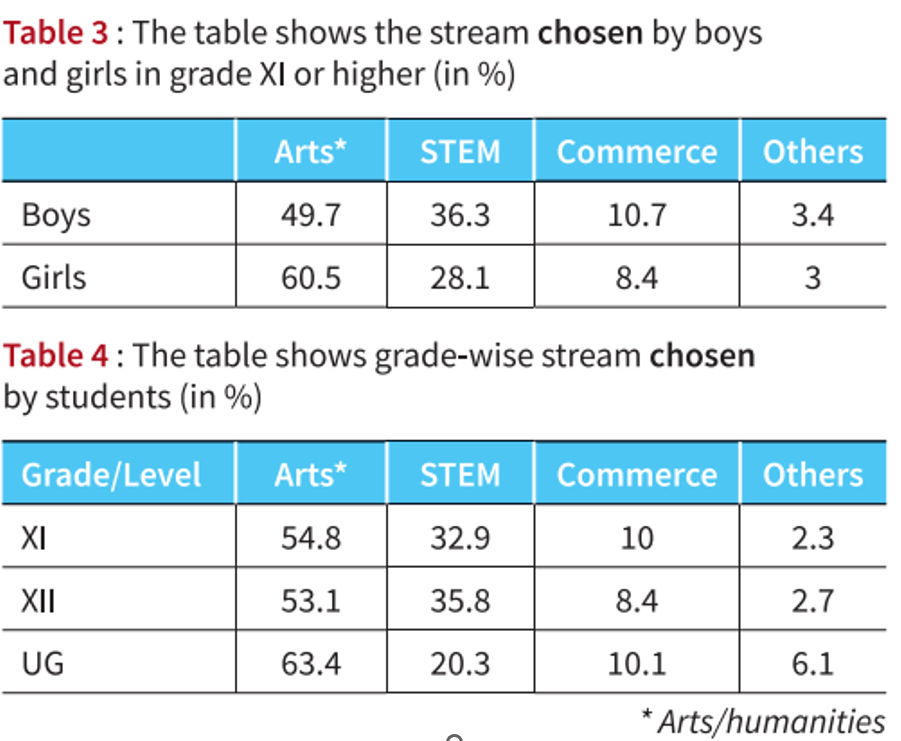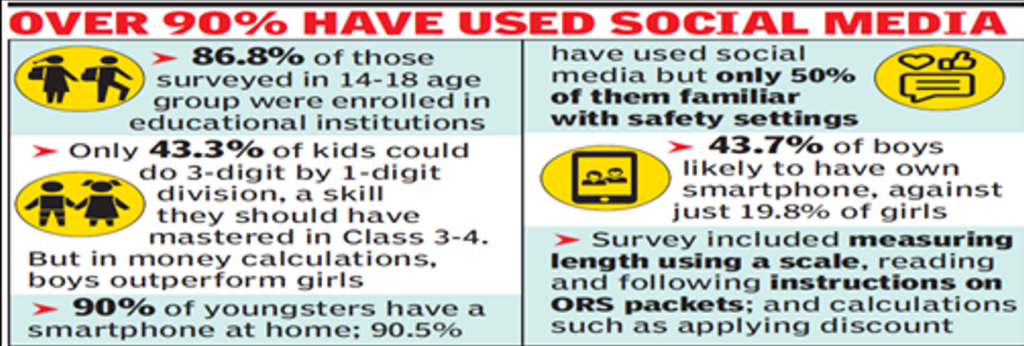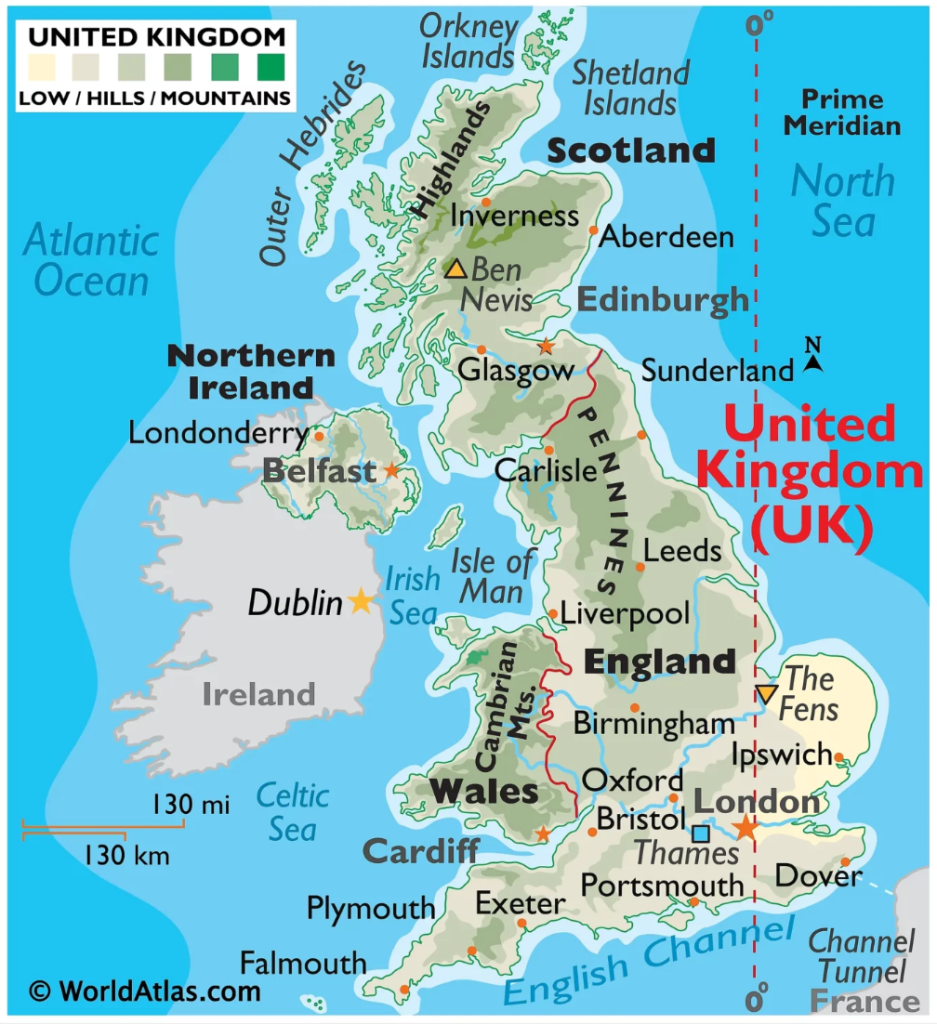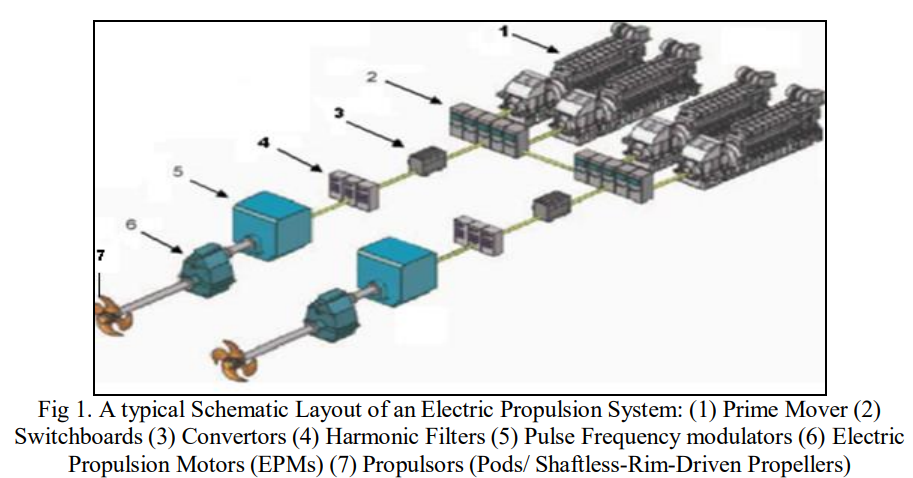CONTENTS
- Annual Status of Education Report (ASER) 2023
- Crafting a new phase in India-U.K. defence ties
Annual Status of Education Report (ASER) 2023
Context:
The recent Annual Status of Education Report (ASER) focuses on a crucial demographic segment essential for India’s demographic dividend – the 14-18-year-olds residing in rural areas. It validates a positive trend, indicating an encouraging increase in students progressing to secondary education.
Relevance:
GS2- Education
Mains Question:
As a nation, it is imperative to provide our youth with the necessary knowledge, skills, and opportunities to empower them in steering their own advancement and contributing to the progress of their families and communities. Discuss in the context of the recently released Annual Status of Education Report (ASER) 2023. (15 Marks, 250 Words).
About ASER:
- The Annual Status of Education Report (ASER), initiated by the Pratham Education Foundation in 2005, is a comprehensive citizen-led household survey designed to assess whether children in rural India are enrolled in school and if they are making progress in their learning.
- The core ASER survey is conducted every alternate year, gathering data on the enrolment status of children aged 3-16 and evaluating the basic reading and arithmetic levels of children aged 5-16.
- Due to the impact of Covid-19, the ASER survey by the Pratham Foundation transitioned to a phone-based approach, concentrating on investigating digital disparities and school enrolment levels.
- However, in 2022, Pratham reinstated its field survey, covering numerous cities across the country to engage in face-to-face interactions with children and teachers in rural India, aiming to gauge the state of learning.
- ASER 2022 involved surveying approximately 7 lakh candidates from 19,060 schools in 616 districts to evaluate post-pandemic learning outcomes for school children. The report revealed that nearly all students (98.4%) in the 6-14 age group are currently enrolled in schools, showcasing an increase from 96.6% in 2010, 96.7% in 2014, and 97.2% in 2018.
- Furthermore, 2022 marked the first time that the percentage of children currently not enrolled in schools decreased to 2% or below. Despite extended school closures during the pandemic, the proportion of children not enrolled in school continued to decline between 2018 and 2022.
- In the intervening years, ASER shifts its focus to various aspects of children’s education and learning. For example, in 2017, the survey concentrated on enrolment patterns, learning levels, awareness, and aspirations of rural youth aged 14-18. In 2019, it delved into the enrolment and school readiness of young children aged 4-8.
- In 2023, ASER once again emphasizes the ability of youth (14-18 years old) to apply reading and math skills to everyday situations and explore their aspirations. Additionally, reflecting the increasing demand for digital literacy, ASER 2023 captured digital access and skills in rural India.
More on the Report:
Impact of COVID19:
Contrary to concerns about the pandemic-induced economic challenges leading to the dropout of older children from school, ASER 2023 reveals that the well-established connection between education and people’s aspirations has prevailed over economic hardships. The report highlights that “today more children in India have more years of schooling than ever before.”
Lack of Foundational Skills:
The more concerning revelations pertain to foundational skills, with approximately one-fourth of surveyed individuals struggling to read a Grade 2 level text in the local language, and over half facing difficulties with arithmetic skills expected to be proficient by Grade 5.
Quality of Labor Force:
This deficit poses a serious concern for the quality of the country’s labor force, emphasizing that no ambitious and well-designed skilling program can succeed when targeted beneficiaries encounter issues with basic reading and arithmetic skills.
Basic Learning Trends:
In the age group of 14-18, approximately 26.5% struggled to read a Class 2-level textbook in their regional language, and nearly 42.7% faced difficulties reading sentences in English.
Among those who could read the sentences, more than a quarter (26.5%) failed to comprehend the meaning of the text. The major challenge lies in basic mathematics, with over half of the surveyed students (56.7%) unable to solve a simple 3-digit by 1-digit division problem. Proficiency in division is considered indicative of fundamental arithmetic skills.
Arithmetic Proficiency:
Approximately 45% of the surveyed youths within this age group exhibit basic arithmetic proficiency, while the remaining individuals need to catch up, as low foundational numeracy levels impede their ability to handle everyday calculations, such as financial computations.
Application of Basic Skills to Everyday Calculations:
Among the surveyed youths, 85% can measure length using a scale when the starting point is 0 cm, but this proficiency sharply drops to 39% when the starting point is changed. This represents a decline compared to 2017 when the percentages were 86% and 40%, respectively. Males consistently outperform females in all everyday calculations.
Enrolment in Different Streams:
The survey indicates that more than half (55.7%) of young people in this age group are enrolled in the Arts/Humanities stream, followed by STEM (31.7%) and Commerce (9.4%). A higher percentage of males enrol in the STEM stream (36.3%) compared to females (28.1%).

Use of Smartphones:
Approximately 89% of those surveyed have a smartphone in their household, with 92% claiming to know how to use it. This shift, observed in the pandemic years and beyond, highlights the prevalence of smartphone usage. However, males are more than twice as likely to own their own smartphones as females, potentially spending more time on the device for various tasks.
Rising Competition:
The report addresses one of the most challenging predicaments in recent education history—the escalating pressure on young students amid intense academic competition. As revealed by ASER 2023, this issue extends beyond urban areas, impacting a segment of learners who must balance academic requirements with responsibilities like working on family farms. ASER proposes a reform of pedagogic processes to alleviate the pressures on these students.

Way Forward:
Using Smartphones for more Inclusive Education:
- The growing prevalence of smartphones in rural areas, with approximately 95% of surveyed households possessing these devices, presents an opportunity to expand education and create classrooms that offer flexibility in terms of time and schedules.
- However, planners need to devise strategies to encourage students and parents to utilize digital technologies for learning. Currently, the use of smartphones for education is significantly lower than for entertainment purposes.
Integration of Digital Technologies:
- NEP 2020 envisions the integration of digital technologies into the educational landscape and advocates a shift from a curriculum-centered approach to one that focuses on the individual learner.
- Insights into the digital and other educational capabilities of youngsters in ASER 2023 could guide policymakers in realizing the goals of NEP. It is essential, however, for them to remain vigilant against succumbing to technological fundamentalism.
- As a nation, it is imperative to provide our youth with the necessary knowledge, skills, and opportunities to empower them in steering their own advancement and contributing to the progress of their families and communities. The optimal realization of India’s anticipated “demographic dividend” and “digital dividend” is contingent on accomplishing this goal.
- The initial emphasis on this age group was illuminated by the ASER report in 2017. Over the subsequent six years, the country has undergone numerous transformations. The ASER 2023 initiative aims to maintain attention on the 14-18 age group and sustain the dialogue regarding the path ahead.
Conclusion:
China has successfully harnessed its demographic dividend through strategic reforms in its technical and vocational education and training systems. However, the ASER report highlights that India is considerably behind in this regard. Vocational skilling is not the primary preference among the youth, with only 6 percent of those surveyed currently enrolled in vocational courses. This should serve as a wake-up call for policymakers to reimagine vocational education, aligning with the vision of the National Education Policy (NEP), and transform it into a genuinely aspirational choice.
Crafting a New Phase in India-U.K. Defence Ties
Context:
Defence Minister Rajnath Singh’s recent trip to the United Kingdom marked the end of a 22-year gap in high-level visits. Over the past few years, significant opportunities have emerged, contrasting with the situation two decades ago. The rise of Chinese military power, especially its expansion into the Indian Ocean, poses a threat to India and the Sea Lines of Communications (SLOCs) crucial to the U.K. This has prompted the British to reassess their strategic priorities.
Relevance:
- GS-2 Effect of Policies and Politics of Countries on India’s Interests
- GS3- Indigenization of Technology & Developing New Technology- Defence
Mains Question:
The expansion of China’s naval power in the Indian Ocean Region (IOR) creates a compelling reason to establish closer defense ties between the U.K. and India. Comment. (10 Marks, 150 Words).
India-U.K Ties:

- India and the UK have developed a robust and diverse strategic partnership, evolving from the economic reforms initiated by India in the early 1990s.
- The elevation of their bilateral relationship to a Strategic Partnership in 2004 marked a significant intensification of ties. In a bid to enhance trade and investment cooperation, formal negotiations for a free trade agreement (FTA) were initiated in January 2022.
- Economic and commercial relations between the two nations have seen substantial growth, with total trade in goods and services reaching USD 32.7 billion from April 2021 to March 2022.
- India holds a trade surplus with the UK, which stands as its 7th largest export destination and the 2nd largest source of foreign direct investment (FDI).
- Key exports from India to the UK include ready-made garments, textiles, gems, and pharmaceuticals, while major imports from the UK consist of precious stones, metals, and machinery.
- The Indian diaspora in the UK constitutes around 2.86% of the country’s population, totalling approximately 1.9 million as per the UK Census 2021. The UK serves as the largest source of European remittances to India.
Collaboration in the Field of Navy:
Shortcomings of the Indian Navy:
- The Indian Navy is facing various capability challenges compared to the People’s Liberation Army Navy (PLAN), and addressing these shortcomings has been a key focus of Singh’s visit to the U.K.
- A crucial aspect of this collaboration involves the U.K.’s assistance in addressing the Indian Navy’s technological gaps in comparison to the Chinese.
- Prior to Singh’s visit, there were preliminary discussions between the Indian and U.K. governments regarding the acquisition of electric propulsion technology for the Indian Navy.
- Despite the PLAN facing technical challenges in implementing electric propulsion, there are emerging yet anecdotal indications that it is in the process of integrating this technology into its warships, such as the Type 054B frigates.
- The Indian Navy cannot passively allow the Chinese navy to gain a significant advantage in acquiring essential maritime technology for their advanced surface combatants in the future.
Electric Propulsion Technology:
About:
- Electric Propulsion Systems are fundamentally based on the utilization of a partially or fully integrated electric power system for both the propulsion and auxiliary services of a ship.
- This involves generating a significantly larger capacity of electric power through parallel-connected prime movers like diesel, gas, or steam engines coupled with diesel generators.
- Subsequently, this integrated pool of electric power is used to fulfil various power needs of the ship, encompassing shaft power for propulsion (via an electric motor), power for weapons and radar systems, and power for auxiliary and support systems.
- The surplus electric power within the system can be redirected to other systems as necessary. This approach ensures that the prime movers consistently operate at their most energy-efficient regimes.
- Unlike conventional or mechanical propulsion systems, electric propulsion eliminates the need for a reduction gearbox and a substantial portion of mechanical shaftlines.
- The adoption of electric propulsion allows ship designers greater flexibility in arranging prime movers and associated support systems in the ship’s general arrangement (GA), enhancing habitability and onboard space management.

London and New Delhi on Electric Propulsion:
- One notable area of cooperation between London and New Delhi is the adoption of electrical propulsion for aircraft carriers.
- Currently, Indian Navy carriers lack this technology, whereas the Royal Navy’s Queen Elizabeth Class aircraft carriers utilize electric propulsion, a technology they have mastered.
- The utilization of electric propulsion provides distinct benefits, such as reducing the acoustic signature of warships by eliminating the connection between the primary mover and propulsion.
- Additionally, it offers the advantage of increased electrical power generation for subsystems in major warships within the Indian Navy’s surface fleet.
Recent Developments in this Domain:
- The formation of a collaborative working group, named the “India-UK electric propulsion capability partnership,” had its inaugural meeting in February 2023.
- Subsequently, a delegation-level discussion occurred on the Royal Navy frigate HMS Lancaster during its port visit to Kochi in March of the same year.
- In the following month, extensive talks transpired regarding the transfer of technical expertise and the Royal Navy’s experiences in maritime electric propulsion for the future major surface combatants of the Indian Navy.
- In November 2023, the India-UK electric propulsion capability partnership reconvened to explore the potential integration of electric propulsion technology into the Indian Navy’s future warships.
- The British have committed to providing training, equipment, and assistance in establishing the necessary infrastructure for developing an electric propulsion system.
- Initially, the technology is set to undergo testing on landing platform docks and subsequently on surface vessels, including the next-generation guided missile destroyers with a displacement exceeding 6,000 tonnes.
Challenges in this Regard:
- One major hurdle involves legacy issues, particularly London’s attempt to balance its ties between India and Pakistan.
- Successive U.K. governments have simultaneously supplied weapons to both India and Pakistan or restricted weapons exports, leading to frustration within India regarding British motives and objectives in the Subcontinent.
- Challenging issues related to Khalistan and Sikh separatism may cast a shadow on the relationship.
- However, the current strategic landscape has undergone a shift due to the emergence of the People’s Republic of China (PRC) as a significant naval power, rapidly expanding its deployments in the Indian Ocean Region (IOR). This shift creates a compelling reason to establish closer defense ties between the U.K. and India.
Conclusion:
India and U.K have already conducted numerous joint military exercises, and there are plans for deeper cooperation in defense industries. During Mr. Singh’s visit, British officials officially announced their intention to deploy a littoral response group—a specialized amphibious warfare group—in 2024 and a carrier strike group in 2025. These deployments aim to enhance training and interoperability with the Indian Navy.




